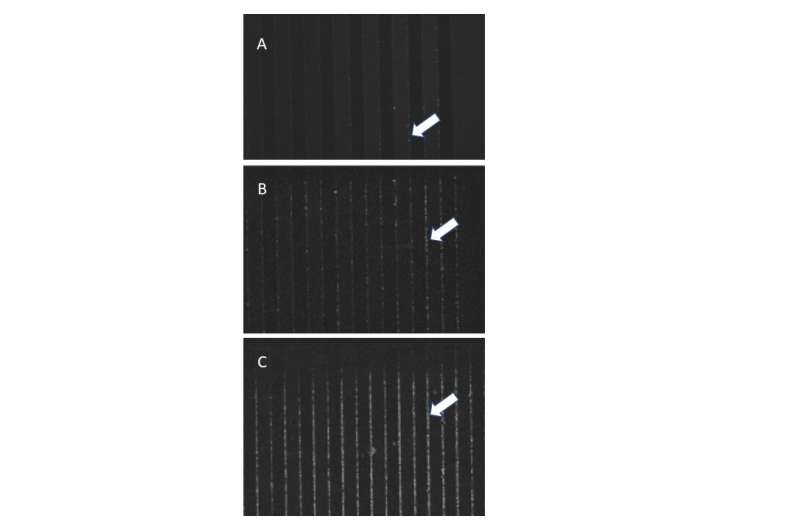This article has been reviewed according to Science X's editorial process and policies. Editors have highlighted the following attributes while ensuring the content's credibility:
fact-checked
peer-reviewed publication
trusted source
proofread
Novel device holds promise for diagnosing tuberculosis in the 'missing millions'

According to the World Health Organization, each year there are approximately three million undiagnosed cases of tuberculosis (TB) globally, which are characterized as the "missing millions." In a cutting-edge study, scientists have tested a diagnostic device using dielectrophoresis that holds promise for improving TB detection and treatment of patients in high-endemic, under-resourced areas. Bringing diagnostics to the patients who need it most will help meet global targets to reduce the burden of TB. The research results appear in The Journal of Molecular Diagnostics.
A unique industry-academia partnership between the TB research team at St George's University of London, Institute for Infection and Immunity, and QuantuMDx, a medical technology company based in the UK, presented an opportunity to prioritize the development of a cheap, rapid, accurate, and portable TB diagnostic test to analyze sputum samples for Mycobacterium tuberculosis (Mtb) from suspected TB patients.
Lead investigator Philip D. Butcher, Ph.D., St George's, University of London, explained, "The global burden of TB is not improving. Although it is infectious, it is highly treatable. However, affordable diagnostics suitable for implementation at the point of care are needed to reach the 'missing millions.' Our TB research group at St George's has a longstanding appreciation of the global imperative for improved diagnostics for TB, and we realized that novel technologies may provide an answer. We saw an opportunity by collaborating on a new chip-based technology using dielectrophoresis to selectively isolate Mtb bacilli from sputum samples."
The investigators describe a prototype microfluidic lab-on-a-chip system called CAPTURE-XT from QuantuMDx that can process solubilized sputum from suspected TB patients, capture Mtb bacilli for visual analysis (as a substitute for smear microscopy), and provide a purified sample for molecular confirmation by quantitative PCR (qPCR) and ultimately for genotypic drug-susceptibility analysis.
CAPTURE-XT technology relies on the principle of dielectrophoresis—a little-utilized technique that can be tuned to selectively attract or repel specific particles or cells based upon their dielectric properties. In this case, it is the Mtb bacteria that cause TB that are specifically captured and concentrated, while the other sputum contents are washed away.
After optimization using a panel of 50 characterized sputum samples, the performance of the prototype was assessed by a blinded screening of 100 characterized and bio-banked sputum samples provided by the Foundation for Innovative New Diagnostics (FIND).
Concordance with culture diagnosis was 100% for smear-negative samples and 87% for smear-positive samples. Of the smear-positive samples, the high-burden sample concordance was 100%. These results demonstrate the potential of the technology to provide a powerful sample preparation tool that could function as a front-end platform for enhanced molecular detection. This versatile tool could equally be applied as a visual detection diagnostic, potentially associated with bacterial identification for low-cost screening.
"The CAPTURE-XT technology is truly revolutionary and will have an impact in many different diseases from sepsis to oncology (circulating tumor cells). This application in Mtb is truly exceptional as its ultra-low cost and ultra-high sensitivity will profoundly improve equitable access to quality diagnoses for hundreds of millions of people," said Jonathan O'Halloran, Ph.D., founder and Chief Executive Officer of QuantuMDx Group. Ltd.
"This chip-based technology exploits the physiological property of the TB bacteria to be specifically collected onto the device so that small numbers can be visualized on the chip electrodes and act as a visual readout to replace the lab-based sputum smear/microscopic methods, which typically have low detection rates and require training laboratory staff, at molecular-like sensitivities and at a fraction of the price. Moreover, when used as a front-end to downstream cellular, protein, and molecular devices, the possibilities are almost limitless."
Professor Butcher concluded, "Collaboration between university-based academic researchers and biotechnology industry scientists presents a way forward to develop new approaches for some of the world's greatest healthcare challenges, such as TB. This new chip-based technology could bring diagnostics to the patients that need it and also, by more accessible case-finding, prevent the further spread of this disease."
Co-author Heather Murton, Ph.D., LEX Diagnostics, Melbourn, UK, and formerly of QuantuMDx Group Ltd., said, "Tuberculosis is one of the oldest challenges faced in human healthcare. This technology has the potential to meet the expectations for a mobile TB diagnostic, and it is exciting to see a seemingly abstract physics principle successfully applied to a neglected disease area."
TB is the 13th leading cause of death worldwide, and until COVID-19 was the leading cause of death from a single infectious disease—more than malaria and HIV. Globally it infects 10 million individuals and kills 1.4 million individuals every year, of whom 230,000 are children.
Diagnostics with increased sensitivity and expanded drug susceptibility testing are also needed to address drug resistance and diagnose low-bacterial burden cases.
More information: A Novel Microfluidic Dielectrophoresis Technology to Enable Rapid Diagnosis of Mycobacteria tuberculosis in Clinical Samples, Journal of Molecular Diagnostics (2023). DOI: 10.1016/j.jmoldx.2023.04.005



















